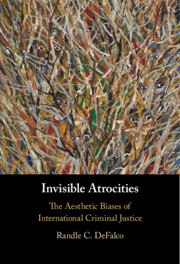Book contents
- Invisible Atrocities
- Invisible Atrocities
- Copyright page
- Contents
- Acknowledgments
- 1 Introduction
- 2 The Atrocity Aesthetic
- 3 Maintaining Invisibility
- 4 Unspectacular Atrocities and International Criminal Law
- 5 Visible and Invisible International Crimes
- 6 The Costs of Invisibility
- 7 Aesthetic Bias and Legal Legitimacy
- 8 Conclusion
- Bibliography
- Index
3 - Maintaining Invisibility
Aesthetic Perception and the Recognition of International Crimes
Published online by Cambridge University Press: 10 March 2022
- Invisible Atrocities
- Invisible Atrocities
- Copyright page
- Contents
- Acknowledgments
- 1 Introduction
- 2 The Atrocity Aesthetic
- 3 Maintaining Invisibility
- 4 Unspectacular Atrocities and International Criminal Law
- 5 Visible and Invisible International Crimes
- 6 The Costs of Invisibility
- 7 Aesthetic Bias and Legal Legitimacy
- 8 Conclusion
- Bibliography
- Index
Summary
This chapter provides an account of why and how the dominant “atrocity aesthetic” model identified in the previous chapter has persisted, despite remaining itself, grounded in unstated and untested assumptions concerning the fundamental nature of the causal dynamics of mass harm causation. It does so by examining the substance, structure, and application of ICL in light of insights from social constructivist norm development theories, and research on the role aesthetic considerations play in individual and social meaning-making processes. Through this analysis, this chapter identifies a variety of factors within the substance and practice of ICL that encourage actors to rely heavily on aesthetic perception when identifying potential international crimes and assessing their relative gravity. These factors include: the complexity of many atrocity situations; the continued presences of considerable zones of ambiguity within ICL; the extreme selectivity of ICL investigations and prosecutions; and the spectacular visibility and self-evident nature of many historical, recent and ongoing situations involving the commission of genocide, crimes against humanity, and/or war crimes.
Keywords
- Type
- Chapter
- Information
- Invisible AtrocitiesThe Aesthetic Biases of International Criminal Justice, pp. 63 - 98Publisher: Cambridge University PressPrint publication year: 2022

